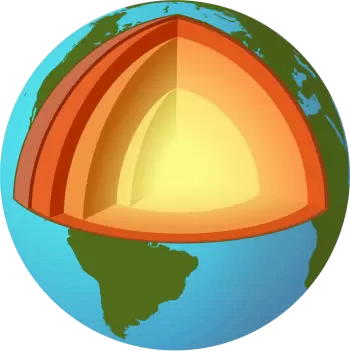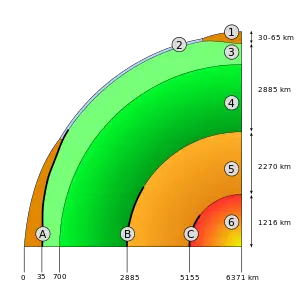
Earth is roughly shaped like a sphere with a diameter of about 12,730 km.
The structure of the Earth consists of several layers formed over millions of years, distinguished by chemical or geological properties: crust, mantle, outer core, and inner core.
In the center, there is an inner core with a radius of about 1,250 km, mainly made up of iron and nickel. Next comes the outer core - mostly iron - with a thickness of about 2200 km. Finally, above it, there are about 2,900 km of a viscous mantle composed of silicates and oxides, and even higher - a relatively thin solid.
We can divide the interior of the Earth into layers based on its mechanical (mainly geological) or chemical properties.
According to the mechanical properties, we can distinguish the following Eart’s parts: lithosphere, asthenosphere, mesosphere, and the inner and outer nuclei.
According to its chemical properties, the Earth can be divided into Earth's crust, upper and lower mantle, and inner and outer core.
Schematic representation of the internal structure of the Earth:
-
Continental crust - composed of the mainland.
-
Oceanic crust - formed of rivers, seas, oceans, etc.
-
Upper mantle.
-
Lower mantle.
-
Outer core (liquid state).
-
The inner core (in solid form).
The three Earth’s layers
Earth has three layers: the crust, the mantle, and the core.
1. The core
The inner core is the innermost layer of the Earth.
Seismic wave measurements show that the core is divided into two parts:
-
A solid inner core with a radius of approximately 1,220 km.
-
A liquid outer core with an approximate radius of 3400 km. Due to high temperatures and pressures, the external nucleus is in a liquid state. It is responsible for the Earth's magnetic field.
2. The mantle
The Earth's mantle extends to a depth of 2,890 km, which makes it the thickest layer on Earth. The pressure in the lower mantle is approximately 140 GPa.
The mantle comprises silicate rocks rich in iron and magnesium concerning the overlying crust. The high temperatures in the mantle make the silicate material plastic enough to allow convection of the material in the mantle, which emerges to the surface through faults in the tectonic plates.
It is divided into two parts:
-
Top: the top is solid, and there are the tectonic plates, which are rigid plates of rock.
-
Bottom part: this part is liquid due to high temperatures. This molten matter is known as magma.
3. The crust
The Earth's crust is the upper part of the Earth. It is the layer on which we live, and it is the thinnest on the planet.
Below the crust is the mantle, which differs in composition and physical properties: it is denser it contains mainly refractory elements.
The earth's crust is divided:
-
The oceanic crust or hydrosphere is found at the bottom of rivers, lakes, seas, and oceans. The hydrosphere’s thickness measures between 5 and 12 kilometers.
-
The continental crust or lithosphere is the layer that occupies the rest of the Earth’s surface. The thickness of this layer is approximately eighty kilometers.
The atmosphere: the outer layers of the Earth
The outer layers of the Earth are made up of gases. The set of them is what we know by atmosphere and is close to a thousand kilometers thick.
-
The troposphere: it is the layer that is in contact with the surface of the Earth and is the gaseous layer that contains the air we breathe and has a thickness of between ten and twelve kilometers. This layer works as a thermal regulator, softening the temperature contrast between day and night thanks to the greenhouse effect that it naturally generates.
-
The stratosphere: it is above the troposphere and is about 50 km thick. The temperature increases with altitude in the stratosphere due to the ozone layer that absorbs solar radiation. The stratosphere is the height at which airplanes usually fly.
-
The mesosphere: it is about thirty kilometers thick and is the coldest layer on earth. The mesosphere destroys the vast majority of asteroids and meteorites that impact it.
-
The ionosphere: The ionosphere contains many electrical particles due to terrestrial radiation.
-
The exosphere: it is the outermost layer of the atmosphere. It is the layer that softens the amount of solar energy that the Earth receives. In this layer, the satellites are placed.